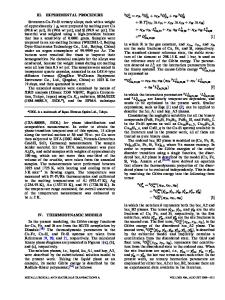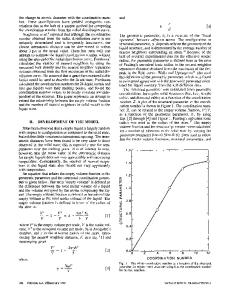Determination of the CoTi congruent melting point and thermodynamic reassessment of the Co-Ti system
- PDF / 233,316 Bytes
- 12 Pages / 612 x 792 pts (letter) Page_size
- 55 Downloads / 324 Views
INTRODUCTION
COBALT and titanium are important components of many industrial alloys. Information on phase equilibria and thermochemistry in the Co-Ti system is essential for the development of thermodynamic databases of Co- and Nibased superalloys. Such databases[1] are important for process modeling; e.g., solidification, homogenization, transient liquid-phase bonding, and ␥/␥⬘ precipitation. In addition to superalloy applications, a new class of Co/Ti multilayer magnetic devices and neutron polarizers is emerging,[2,3] and Co/Ti metallization on Si chips is being developed for electronic devices.[4] These latter applications make knowledge of the Co-Ti system an important tool for predicting intermetallic phase formation and stability during industrial processing. Therefore, an accurate experimental and thermodynamic re-evaluation of the Co-Ti system is necessary. The phase diagram evaluated by Murray,[5] with all experimental data, is shown in Figure 1. The diagram contains two groups of phases: (1) the disordered solutions: liquid, A3 (Co- and Ti-rich hcp), A1 (Co-rich fcc), and A2 (Ti-rich bcc) terminal solid solutions; (2) plus five intermetallics: L12 (Co3Ti), the C36 (Co2+xTi1⫺x) and C15 (Co2Ti) Laves phases, B2 (CoTi), and the NiTi2-type compound (CoTi2). The B2 is the only intermediate phase forming congruently from the liquid. Its maximum melting temperature is uncertain, with reported Tm values varying between 1593 and 1811 K.[6–11] This article reports an experimental determination of the B2 melting point and a new thermodynamic assessment of the Co-Ti system, utilizing standard CALPHAD (Calculation of Phase Diagrams) procedures and packages.[12,13] II. THE B2 MELTING-POINT EXPERIMENTS A. Literature Overview Among the most important issues in the system is the inconsistency in the melting-temperature data for the B2 A.V. DAVYDOV, Chemist, U.R. KATTNER, Physical Scientist, D. JOSELL, R.M. WATERSTRAT, and W.J. BOETTINGER, Metallurgists, J.E. BLENDELL, Ceramist, and A.J. SHAPIRO, Physicist, are with the National Institute of Science and Technology, Gaithersburg, MD 20899. Manuscript submitted January 10, 2001. METALLURGICAL AND MATERIALS TRANSACTIONS A
phase. The following maximum melting temperatures are reported in the literature (from the lowest to the highest): 1593 K,[6] 1623 K,[7] 1722 K,[8] 1773 K,[9] 1799 K,[10] and 1811 K[11] (refer also to Figure 1). The ⬇220 K range of the experimental Tm values might be associated with two factors. The “upper-limit” data, which potentially overestimate the B2 melting temperature, might be linked to contamination of samples with oxygen (or other interstitial elements), which is known to stabilize cobalt-titanium intermetallic phases.[14] Indeed, Pet’kov and Kireev[11] reported a new high-melting-point Ti-rich phase close to the B2 composition that was never confirmed to exist in other studies. Similarly, other high-temperature Tm data were obtained using low-purity titanium with a Ti mass fraction of 95 pct.[8] The “lower-limit” Tm data[6,7] might be linked to
Data Loading...











